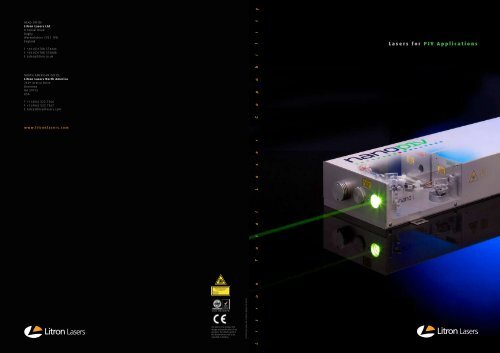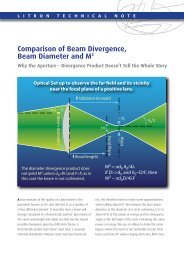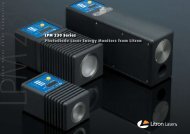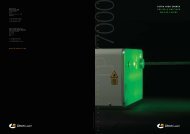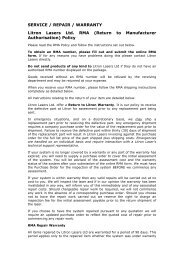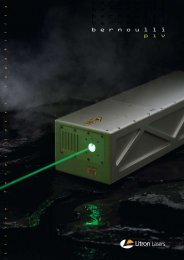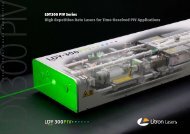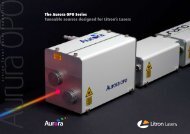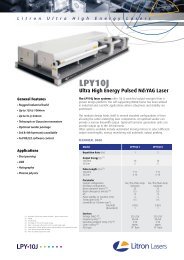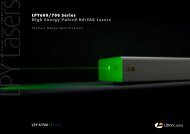Litron PIV Laser Products Brochure (PDF file 1.7 - Litron Lasers
Litron PIV Laser Products Brochure (PDF file 1.7 - Litron Lasers
Litron PIV Laser Products Brochure (PDF file 1.7 - Litron Lasers
Create successful ePaper yourself
Turn your PDF publications into a flip-book with our unique Google optimized e-Paper software.
HEAD OFFICE<br />
<strong>Litron</strong> <strong>Laser</strong>s Ltd<br />
8 Consul Road<br />
Rugby<br />
Warwickshire CV21 1PB<br />
England<br />
T +44 (0)1788 574444<br />
F +44 (0)1788 574888<br />
E sales@litron.co.uk<br />
NORTH AMERICAN OFFICE<br />
<strong>Litron</strong> <strong>Laser</strong>s North America<br />
2449 Arnica Drive<br />
Bozeman<br />
MT 59715<br />
USA<br />
T +1 (406) 522 7566<br />
F +1 (406) 522 7567<br />
E sales@litronlasers.com<br />
www.litronlasers.com<br />
Our policy is to improve the<br />
design and specification of our<br />
products. The details given in<br />
this document are not to be<br />
regarded as binding.<br />
© 2010 <strong>Litron</strong> <strong>Laser</strong>s Ltd. Printed in England. PB 0109:2<br />
L i t r o n T o t a l L a s e r C a p a b i l i t y<br />
<strong>Laser</strong>s for <strong>PIV</strong> Applications
<strong>Laser</strong>s for <strong>PIV</strong> Applications<br />
<strong>Litron</strong> offers an extensive range of flashlamp<br />
pumped and diode pumped <strong>PIV</strong> laser systems<br />
with output energies of up to 1J per pulse and<br />
repetition rates of up to 200Hz for flashlamp<br />
systems and up to 20kHz for diode pumped<br />
systems. All of the systems are twin head<br />
devices, meaning that the <strong>PIV</strong> laser head contains<br />
two totally independent lasers. The range of <strong>PIV</strong><br />
systems is based around both the ultra-compact<br />
Nano series and the larger invar stabilised LPY<br />
and LDY series. The overriding factor that sets<br />
<strong>Litron</strong>’s products apart is quality. This is evidenced<br />
not only in the design and construction of the<br />
product, but also in its performance.<br />
In any imaging application the beam quality is<br />
of paramount importance as this completely<br />
determines the light sheet quality. By choosing a<br />
suitable resonator configuration the output beam<br />
quality can be controlled to give a very smooth<br />
spatial pro<strong>file</strong> which remains homogeneous as it<br />
propagates through to the far field. Such<br />
resonators are almost always of a stable or sta-<br />
ble-telescopic configuration. Unstable Gaussian-<br />
coupled resonators are not in general ideal for<br />
visualisation applications. These resonators<br />
produce very good Gaussian spatial pro<strong>file</strong>s with<br />
low divergence in the far field, however, in the<br />
near to intermediate fields (within 10m of the<br />
laser output) the beam spatial pro<strong>file</strong> often has<br />
significant structure to it. This phenomenon is<br />
typical of this resonator design and is a result of<br />
the physics of the system making it unsuitable for<br />
forming uniform light sheets.<br />
It is our philosophy to provide a laser system<br />
that suits an application. A ‘one system fits all’<br />
approach, as offered by most manufacturers, does<br />
not allow the customer to optimise their process.<br />
For applications such as <strong>PIV</strong> <strong>Litron</strong> has developed<br />
resonators that will yield extremely uniform light<br />
sheets whose pulse to pulse structure remains<br />
extremely constant. These are all based around<br />
our stable and stable - telescopic resonators.<br />
3<br />
1<br />
2<br />
Rear Mirror<br />
Q-Switch<br />
Nd:YAG Rod<br />
Schematics showing<br />
oscillator design.<br />
1) Stable<br />
2) Gaussian<br />
3) Stable Telescopic<br />
TEM 00 resonators can also be<br />
offered with the inclusion of an<br />
intra-cavity aperture.<br />
Resonator Design<br />
The Heart of the <strong>Litron</strong> System<br />
Stable Resonator<br />
A stable resonator provides the most flexibility<br />
in terms of output energy and repetition rate, as<br />
both parameters can be varied with minimal<br />
effect upon the alignment of the system.<br />
In general, the output of such systems is<br />
multi-mode. With the addition of an intra-cavity<br />
aperture, a TEM 00 output can easily be realised at<br />
the expense of some of the overall energy.<br />
Gaussian Optics<br />
In a Gaussian system, a graded reflectivity output<br />
mirror is used as part of a geometrically unstable<br />
resonator. Such systems give a high energy single<br />
transverse mode with a low beam divergence.<br />
The thermal lens formed by the laser rod is part<br />
of the optical arrangement. Therefore,<br />
Gaussian systems work best at a constant aver-<br />
age input power (i.e. lamp energy and repetition<br />
Output Coupler<br />
Graded Reflectivity<br />
Output Coupler<br />
Rear Mirror Aperture<br />
Telescope Q-Switch Nd:YAG Rod<br />
Output Coupler<br />
frequency). As such, the laser is factory<br />
set at one pulse repetition frequency<br />
and output energy. To increase flexibility,<br />
<strong>Litron</strong> offers two options. The first<br />
option, the pulse repetition rate divider<br />
allows the user to divide the set<br />
repetition rate by 2, 4, 8 or 16. This<br />
works by allowing the flashlamp to pulse at a set<br />
frequency, thus maintaining the same thermal<br />
load on the laser rod, but only switching the<br />
Pockels cell on the desired pulses (i.e. every other<br />
pulse for divide by two operation).<br />
Telescopic Resonator<br />
To obtain high energy, low divergence beams, the<br />
preferred method is the use of a telescopic<br />
resonator. In this configuration, an intra-cavity<br />
telescope is used to reduce the beam diameter<br />
in the rear of the resonator. This makes the<br />
resonator appear longer, increasing the lower<br />
order mode volumes, leading to a superior output<br />
beam with very low divergence. With no optical<br />
adjustment at all, the laser can be varied over a<br />
wide range of pulse energies and repetition rates,<br />
maintaining a high quality, low divergence beam.<br />
With slight adjustment to the telescope (a simple<br />
procedure) the full range of energies and repeti-<br />
tion rates from single pulse to the maximum can<br />
be achieved. For high energy TEM00 beams, an<br />
intra-cavity aperture can be fitted behind the<br />
telescope. Varying the sizes of these apertures<br />
allow output beams that are to within 15% of the<br />
diffraction limit to about 3.5 times the<br />
diffraction limit. That is from an almost pure<br />
Gaussian TEM 00 to full energy in a uniform spatial<br />
pro<strong>file</strong>, giving a high degree of control over light<br />
sheet characteristics.<br />
Optical Attenuator<br />
Energy output can be controlled via the variable<br />
optical attenuator. The output energy of the laser<br />
can be attenuated by the use of an extra-cavity<br />
polariser and half wave plate, whilst maintaining<br />
the beam quality and divergence.<br />
This also has the advantage that the pulse to<br />
pulse stability is maintained even at very low<br />
output energies.
NANO <strong>PIV</strong> FEATURES<br />
• Compact dual head design<br />
• Dedicated <strong>PIV</strong> laser head<br />
• Stable resonator design<br />
• Telescopic versions for<br />
low divergence<br />
• Rugged for industrial<br />
environments<br />
• 3rd and 4th harmonics<br />
available for LIF and<br />
dual colour <strong>PIV</strong><br />
• Rep. rates to 200Hz<br />
• Energies up to 425mJ @ 532nm<br />
Schematic showing the<br />
Nano <strong>PIV</strong> laser harmonic<br />
generation options.<br />
532nm<br />
Output Only<br />
<strong>Laser</strong> 2<br />
Option 1<br />
<strong>Laser</strong> 1<br />
1064nm<br />
Beam Dump<br />
2HG Unit<br />
3HG/4HG Unit<br />
532nm<br />
Beam Dump<br />
Compact <strong>Laser</strong>s for <strong>PIV</strong> Applications<br />
The Nano <strong>PIV</strong> Series<br />
Nano <strong>PIV</strong><br />
The construction of the Nano series of <strong>PIV</strong> laser<br />
systems is extremely robust. They have been<br />
developed as industrial tools that can be handled<br />
without worry of misalignment or damage. The<br />
<strong>PIV</strong> head is formed by an aluminium gauge-plate<br />
onto which two standard Nano series heads are<br />
mounted. The output beams are combined by<br />
dielectric polarisers and then frequency doubled,<br />
and if desired can be frequency tripled,<br />
quadrupled or quintupled. Many of the Nano <strong>PIV</strong><br />
systems are powered by a single power supply<br />
unit, making the overall package both powerful<br />
and portable.<br />
There are two twin power supplies available, the<br />
LPU450-<strong>PIV</strong> and the LPU550- <strong>PIV</strong>, the latter<br />
allowing outputs of up to 200mJ at 532nm at<br />
15Hz from each laser. The laser systems are<br />
controlled via a remote controller or via RS232<br />
355nm/266nm<br />
Output Only<br />
<strong>Laser</strong> 2<br />
Option 2 Option 3<br />
<strong>Laser</strong> 1<br />
3HG/4HG Unit<br />
<strong>Laser</strong> 2<br />
532nm/355nm/266nm<br />
Combined Output<br />
<strong>Laser</strong> 1<br />
Optional<br />
Attenuator<br />
interface . All trigger and synchronisation signals<br />
are TTL compatible and each laser is controllable<br />
entirely independently.<br />
All Nano laser heads have a verified electronic<br />
intracavity safety shutter as standard, which<br />
ensures that the lasers cannot be started with the<br />
shutter open – an important safety feature.<br />
The Nano L <strong>PIV</strong> range also includes high repetition<br />
rate models giving energies of up to 50mJ per<br />
pulse at 100Hz from each laser using a power<br />
supply that is completely air cooled.<br />
The Nano T <strong>PIV</strong> range has been designed<br />
incorporating stable telescopic resonators, giving<br />
very low divergence output beams that allow<br />
thinner light sheets to be formed than from<br />
conventional stable resonators.<br />
For large area illumination, high energies are<br />
achieved with the birefringence compensated<br />
Nano TRL range which achieves output energies<br />
of up to 450mJ per pulse at 532nm, 10Hz.<br />
The footprint of the head is an extremely compact<br />
at 908mm x 270mm.<br />
Nano L <strong>PIV</strong><br />
Nano TRL <strong>PIV</strong><br />
Harmonic Generation Unit
The Nano <strong>PIV</strong> Series Specifications<br />
81<br />
Model Nano S Nano S Nano S Nano S Nano L Nano L Nano L Nano L Nano L Nano T Nano T Nano TRL Nano TRL Nano TRL Nano TRL Nano TRL Nano TRL<br />
30-15 <strong>PIV</strong> 30-30 <strong>PIV</strong> 50-20 <strong>PIV</strong> 65-15 <strong>PIV</strong> 200-15 <strong>PIV</strong> 135-15 <strong>PIV</strong> 50-50 <strong>PIV</strong> 100-50 <strong>PIV</strong> 50-100 <strong>PIV</strong> 180-15 <strong>PIV</strong> 135-15 <strong>PIV</strong> 250-20 <strong>PIV</strong> 325-15 <strong>PIV</strong> 300-20 <strong>PIV</strong> 425-10 <strong>PIV</strong> 400-15 <strong>PIV</strong> 400-20 <strong>PIV</strong><br />
Repetition Rate<br />
per <strong>Laser</strong> Head (Hz) 0-15 0-30 0-20 0-15 0-15 0-15 0-50 0-50 0-100 15 15 20 15 20 10 15 20<br />
Output Energy at 532nm<br />
per <strong>Laser</strong> Head (1) (mJ) 30 30 50 65 200 135 50 100 50 180 135 250 325 300 425 400 400<br />
Parameter<br />
Pulse - Pulse Stability (±%) 2 2 2 2 2 2 2 2 2 2 2 2 2 2 2 2 2<br />
Beam Diameter (mm) 3 3 4 4 6.5 5 4 4 4 6.35 5 6.35 8 9.5 9.5 9.5 9.5<br />
Beam Divergence (mrad) ~2.0 ~2.0 ~2.5 ~2.5 ~3 ~3 ~2 ~2 ~2 0.8 0.8
BERNOULLI <strong>PIV</strong> FEATURES<br />
• Vibration & shock proof<br />
• Fully sealed laser head<br />
• 2 year warranty<br />
• Ability to operate in all<br />
orientations<br />
• Compact size<br />
• Fast connections & start -up<br />
• Motorised attenuator fitted as<br />
standard<br />
• High frequency options also<br />
available<br />
Vibration & Shock Proof, Ultra Ruggedized<br />
<strong>Laser</strong> for <strong>PIV</strong> Applications in Demanding<br />
Environments<br />
The Bernoulli <strong>PIV</strong> Series<br />
Bernoulli <strong>PIV</strong> <strong>Laser</strong> System.<br />
From wind tunnels to wind farms the bernoulli<br />
is suited to operation in almost any environment.<br />
The new bernoulli <strong>PIV</strong> from <strong>Litron</strong> is the most<br />
advanced plug and play’ <strong>PIV</strong> laser system<br />
available today. It benefits from<br />
<strong>Litron</strong>’s years of experience in this<br />
field and the expertise gained<br />
from being the World’s leading<br />
<strong>PIV</strong> laser manufacturer.<br />
Rugged<br />
Vibration and shock proof -<br />
for use in rough environments.<br />
Fully sealed laser head – protection from dust<br />
and moisture.<br />
Ruggedized oscillator – fixed mirror design adds<br />
to oscillator alignment stability.<br />
Reliable<br />
2 Year warranty includes Optics, PSU & <strong>Laser</strong><br />
head.<br />
2 Year warranted alignment and overlap –<br />
All components locked into position in a separate<br />
compartment.<br />
Portable<br />
Ability to operate in all orientations.<br />
Compact size – strengthened and lightened<br />
aluminium monolithic body.<br />
Fast connections at the laser head and PSU –<br />
easy to transport and set-up.<br />
Intelligent<br />
MOBIUS - Microprocessor control and<br />
monitoring of all laser parameters.<br />
Standardised PSU – Mobius configures the PSU<br />
to the laser head.<br />
Accurate internal pulse generator – No third<br />
party timing equipment required.<br />
Easy to Use<br />
Auto start up and touch screen control.<br />
LUCi remote interface -<br />
provides all functions at the touch<br />
of a button.<br />
Motorised attenuator fitted as<br />
standard – 1000 step energy control.<br />
Alignment mode - sets attenuator to allow<br />
alignment of external optics.<br />
The Bernoulli <strong>PIV</strong> Series Specifications<br />
Model B-<strong>PIV</strong> 200-15 B-<strong>PIV</strong> 135-15 B-<strong>PIV</strong> 120-20 B-<strong>PIV</strong> 100-25<br />
Wavelength (nm) 532nm<br />
Pulse repetition rate (Hz) 0-15 0-15 0-20 0-25<br />
Pulse energy @ 532nm (mJ) (1) 200 135 120 100<br />
Pulse to pulse energy stability (%pk-pk)
LPY <strong>PIV</strong> FEATURES<br />
• Dedicated <strong>PIV</strong> laser head<br />
• Frequencies up to 200Hz<br />
• High pulse energies up to 1J<br />
• True TEM 00 output available<br />
• Stable resonator design<br />
• Telescopic versions for low<br />
divergence<br />
• 3rd and 4th harmonics<br />
available for LIF and<br />
dual colour <strong>PIV</strong><br />
• Low pro<strong>file</strong> INVAR optical rail<br />
• Line narrowed versions<br />
• Rugged industrial design<br />
High Energy & High Repetition Rate<br />
<strong>Laser</strong>s for <strong>PIV</strong><br />
The LPY <strong>PIV</strong> Series<br />
LPY <strong>PIV</strong><br />
For higher energy systems or systems where very<br />
low divergences are required <strong>Litron</strong> offers twin<br />
configurations of its invar stabilised LPY series.<br />
Output energies of up to 1J per pulse of 532nm at<br />
repetition rates of up to 20Hz are available as<br />
standard, as are outputs of 100mJ at 532nm<br />
at 200Hz.<br />
The LPY <strong>PIV</strong> series are based<br />
around a rugged, self supporting,<br />
invar rail. This imparts both a large<br />
degree of mechanical and thermal<br />
stability to the system suiting<br />
them to use in both research<br />
and industrial applications with little need for<br />
maintenance.<br />
The LPY <strong>PIV</strong> series can have a stable or a stable -<br />
telescopic resonator design, with the intra-cavity<br />
telescope yielding a lower divergence output.<br />
All LPY700 series systems feature a birefringence<br />
compensating twin-rod design<br />
to give the best possible beam<br />
homogeneity, essential for the<br />
formation of uniform light sheets.<br />
The modular construction of the LPY series laser<br />
heads allows for easy customisation of systems.<br />
Options include variable optical attenuation,<br />
line-narrowing etalons, injection seeding and<br />
third, fourth and fifth harmonic outputs.<br />
139<br />
The LPY <strong>PIV</strong> Series Specifications<br />
Model LPY LPY LPY LPY LPY LPY LPY LPY LPY<br />
706-20<strong>PIV</strong> 707-20<strong>PIV</strong> 704-30<strong>PIV</strong> 706-15<strong>PIV</strong> 707-15<strong>PIV</strong> 704-100<strong>PIV</strong> 703-200<strong>PIV</strong> 742-100<strong>PIV</strong> 742-200<strong>PIV</strong><br />
Repetition Rate<br />
per <strong>Laser</strong> Cavity (Hz) 20 20 30 15 15 100 200 100 200<br />
Output Energy at 532nm<br />
per laser head (mJ) 300 400 200 325 425 100 50 200 100<br />
Parameter<br />
Pulse Stability @ 532nm (±%)
LDY <strong>PIV</strong> FEATURES<br />
• High Energy at 527nm<br />
• 0-20kHz continuously variable<br />
• Field replaceable pump module<br />
• Dedicated <strong>PIV</strong> laser head<br />
• Low pro<strong>file</strong> INVAR optical rail<br />
• Rugged industrial design<br />
High Repetition Rate <strong>Laser</strong>s for<br />
High Speed Imaging Applications<br />
The LDY300 <strong>PIV</strong> Series<br />
LDY <strong>PIV</strong><br />
The LDY300 series are diode pumped, dual cavity,<br />
Q-switched Nd:YLF laser systems ideally suited<br />
to high speed <strong>PIV</strong> imaging applications. Output<br />
energies of up to 30mJ at 1kHz per cavity at<br />
527nm are available. The lasers are built around a<br />
rugged self supporting<br />
invar rail that bestows<br />
excellent mechanical<br />
and optical stability.<br />
This, coupled with the<br />
proprietary resonator<br />
design, leads to<br />
excellent output beams that are spatially and<br />
temporally extremely smooth and<br />
stable, giving rise to light sheets that<br />
offer almost identical shot to shot<br />
illumination.<br />
The robust design of these lasers make<br />
them suitable for the harshest of industrial<br />
environments and research<br />
applications alike.<br />
The power supply and<br />
closed-circuit chiller<br />
are all housed in a<br />
compact 10U or 12U 19” cabinet. The system<br />
can be controlled either by the in-built LCD or via<br />
RS232 interface using the supplied software suite<br />
or dll. The system can be externally triggered for<br />
output frequencies from 0 - 20 kHz using the TTL<br />
interface.<br />
139<br />
The LDY <strong>PIV</strong> Series Specifications<br />
Performance Data<br />
326<br />
163<br />
81<br />
Model LDY301 <strong>PIV</strong> LDY302 <strong>PIV</strong> LDY303 <strong>PIV</strong> LDY303HE <strong>PIV</strong> LDY304 <strong>PIV</strong><br />
Repetition rate (each cavity) (kHz) 1-20 1-20 1-20 1-20 0.2º-20<br />
Output Energy at 1kHz at 527nm<br />
per laser head per pulse (mJ) 10 15 20 22.5 30<br />
Pulse - pulse stability (±%) 1 1 1 1 1<br />
Beam diameter (mm) (4) 5 5 5 5 5<br />
Beam divergence (mrad) (5)


